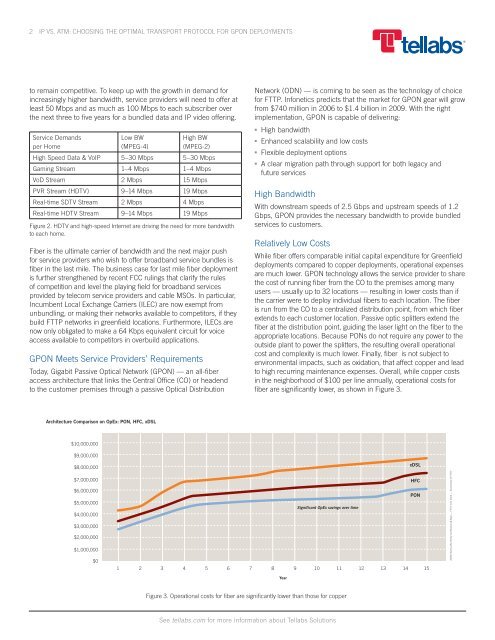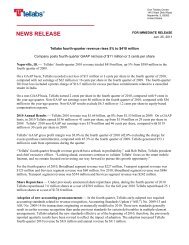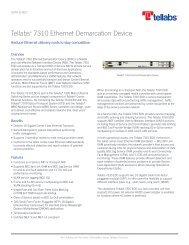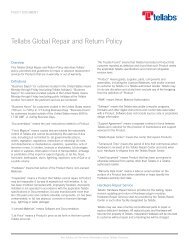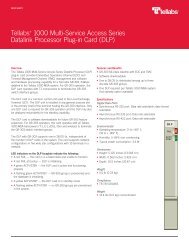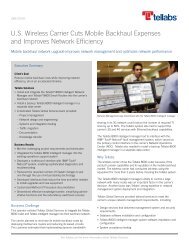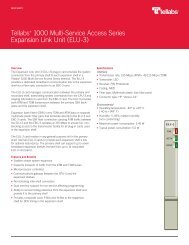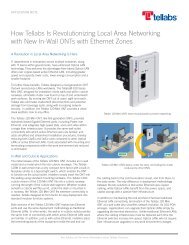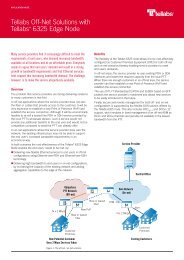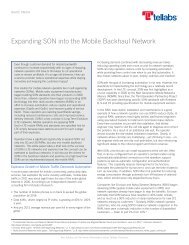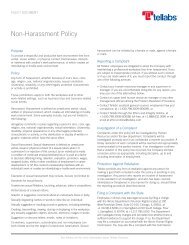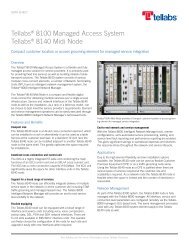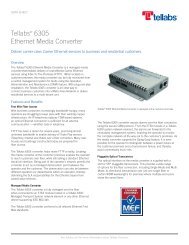IP vs. ATM: Choosing the Optimal Transport Protocol for ... - Tellabs
IP vs. ATM: Choosing the Optimal Transport Protocol for ... - Tellabs
IP vs. ATM: Choosing the Optimal Transport Protocol for ... - Tellabs
Create successful ePaper yourself
Turn your PDF publications into a flip-book with our unique Google optimized e-Paper software.
2 <strong>IP</strong> VS. <strong>ATM</strong>: CHOOSING THE OPTIMAL TRANSPORT PROTOCOL FOR GPON DEPLOYMENTS<br />
to remain competitive. To keep up with <strong>the</strong> growth in demand <strong>for</strong><br />
increasingly higher bandwidth, service providers will need to offer at<br />
least 50 Mbps and as much as 100 Mbps to each subscriber over<br />
<strong>the</strong> next three to five years <strong>for</strong> a bundled data and <strong>IP</strong> video offering.<br />
Service Demands<br />
per Home<br />
Low BW<br />
(MPEG-4)<br />
High BW<br />
(MPEG-2)<br />
High Speed Data & Vo<strong>IP</strong> 5–30 Mbps 5–30 Mbps<br />
Gaming Stream 1–4 Mbps 1–4 Mbps<br />
VoD Stream 2 Mbps 15 Mbps<br />
PVR Stream (HDTV) 9–14 Mbps 19 Mbps<br />
Real-time SDTV Stream 2 Mbps 4 Mbps<br />
Real-time HDTV Stream 9–14 Mbps 19 Mbps<br />
Figure 2. HDTV and high-speed Internet are driving <strong>the</strong> need <strong>for</strong> more bandwidth<br />
to each home.<br />
Fiber is <strong>the</strong> ultimate carrier of bandwidth and <strong>the</strong> next major push<br />
<strong>for</strong> service providers who wish to offer broadband service bundles is<br />
fiber in <strong>the</strong> last mile. The business case <strong>for</strong> last mile fiber deployment<br />
is fur<strong>the</strong>r streng<strong>the</strong>ned by recent FCC rulings that clarify <strong>the</strong> rules<br />
of competition and level <strong>the</strong> playing field <strong>for</strong> broadband services<br />
provided by telecom service providers and cable MSOs. In particular,<br />
Incumbent Local Exchange Carriers (ILEC) are now exempt from<br />
unbundling, or making <strong>the</strong>ir networks available to competitors, if <strong>the</strong>y<br />
build FTTP networks in greenfield locations. Fur<strong>the</strong>rmore, ILECs are<br />
now only obligated to make a 64 Kbps equivalent circuit <strong>for</strong> voice<br />
access available to competitors in overbuild applications.<br />
GPON Meets Service Providers’ Requirements<br />
Today, Gigabit Passive Optical Network (GPON) — an all-fiber<br />
access architecture that links <strong>the</strong> Central Office (CO) or headend<br />
to <strong>the</strong> customer premises through a passive Optical Distribution<br />
Network (ODN) — is coming to be seen as <strong>the</strong> technology of choice<br />
<strong>for</strong> FTTP. Infonetics predicts that <strong>the</strong> market <strong>for</strong> GPON gear will grow<br />
from $740 million in 2006 to $1.4 billion in 2009. With <strong>the</strong> right<br />
implementation, GPON is capable of delivering:<br />
• High bandwidth<br />
• Enhanced scalability and low costs<br />
• Flexible deployment options<br />
• A clear migration path through support <strong>for</strong> both legacy and<br />
future services<br />
High Bandwidth<br />
With downstream speeds of 2.5 Gbps and upstream speeds of 1.2<br />
Gbps, GPON provides <strong>the</strong> necessary bandwidth to provide bundled<br />
services to customers.<br />
Relatively Low Costs<br />
While fiber offers comparable initial capital expenditure <strong>for</strong> Greenfield<br />
deployments compared to copper deployments, operational expenses<br />
are much lower. GPON technology allows <strong>the</strong> service provider to share<br />
<strong>the</strong> cost of running fiber from <strong>the</strong> CO to <strong>the</strong> premises among many<br />
users — usually up to 32 locations — resulting in lower costs than if<br />
<strong>the</strong> carrier were to deploy individual fibers to each location. The fiber<br />
is run from <strong>the</strong> CO to a centralized distribution point, from which fiber<br />
extends to each customer location. Passive optic splitters extend <strong>the</strong><br />
fiber at <strong>the</strong> distribution point, guiding <strong>the</strong> laser light on <strong>the</strong> fiber to <strong>the</strong><br />
appropriate locations. Because PONs do not require any power to <strong>the</strong><br />
outside plant to power <strong>the</strong> splitters, <strong>the</strong> resulting overall operational<br />
cost and complexity is much lower. Finally, fiber is not subject to<br />
environmental impacts, such as oxidation, that affect copper and lead<br />
to high recurring maintenance expenses. Overall, while copper costs<br />
in <strong>the</strong> neighborhood of $100 per line annually, operational costs <strong>for</strong><br />
fiber are significantly lower, as shown in Figure 3.<br />
Architecture Comparison on OpEx: PON, HFC, xDSL<br />
$10,000,000<br />
$9,000,000<br />
$8,000,000<br />
$7,000,000<br />
$6,000,000<br />
$5,000,000<br />
$4,000,000<br />
$3,000,000<br />
$2,000,000<br />
$1,000,000<br />
$0<br />
xDSL<br />
HFC<br />
PON<br />
Significant OpEx savings over time<br />
1 2 3 4 5 6 7 8 9 10 11 12 13 14 15<br />
Year<br />
2004 Fiber-to-<strong>the</strong>-Home Conference & Expo — FTTH 101 Track — Economics of FTTH<br />
Figure 3. Operational costs <strong>for</strong> fiber are significantly lower than those <strong>for</strong> copper<br />
See tellabs.com <strong>for</strong> more in<strong>for</strong>mation about <strong>Tellabs</strong> Solutions


